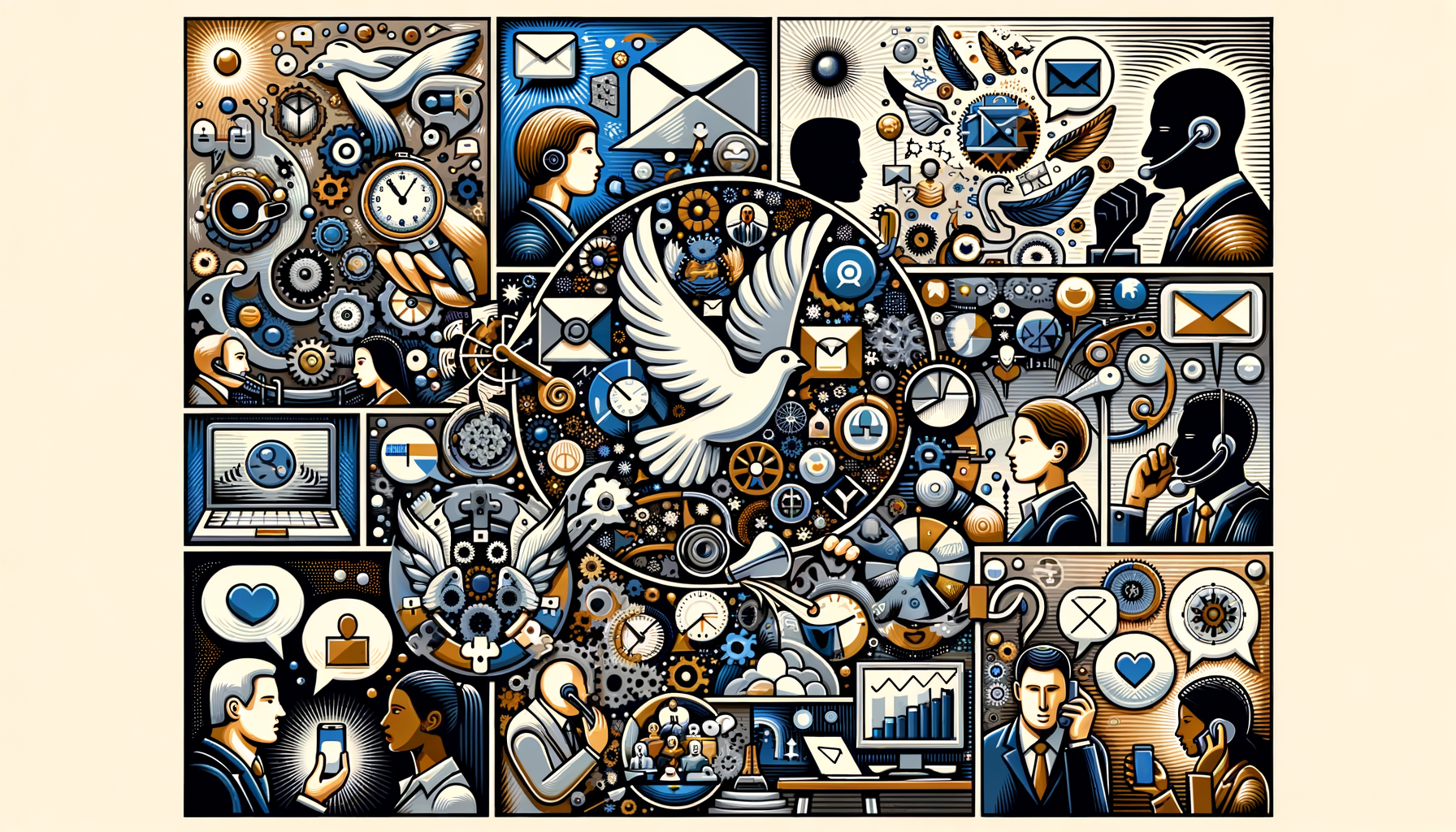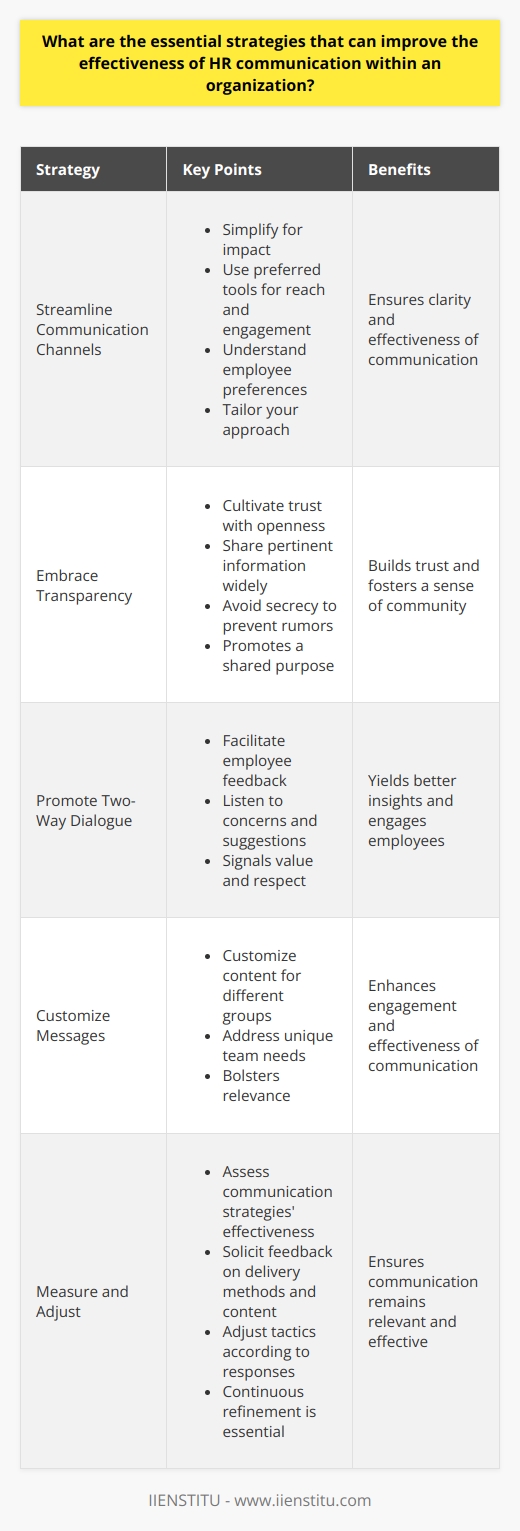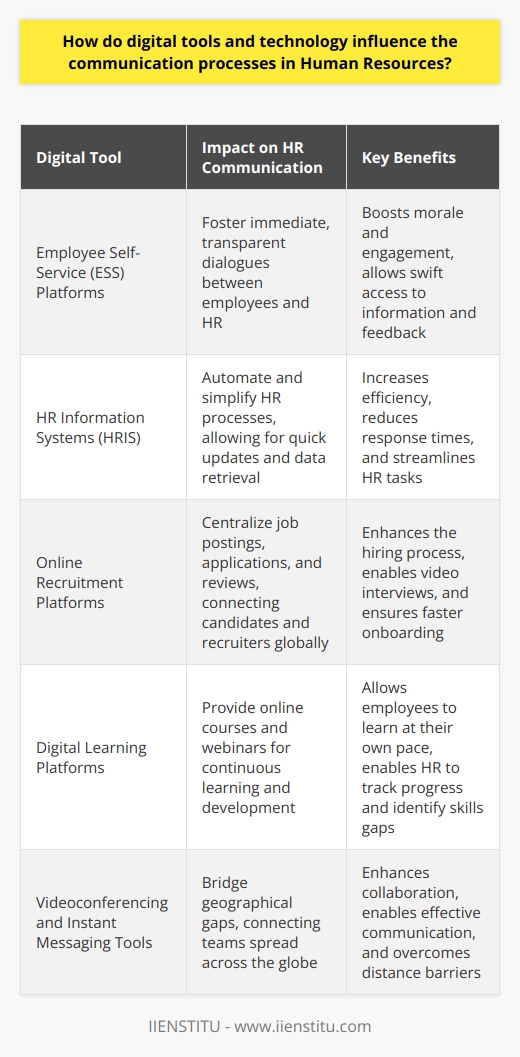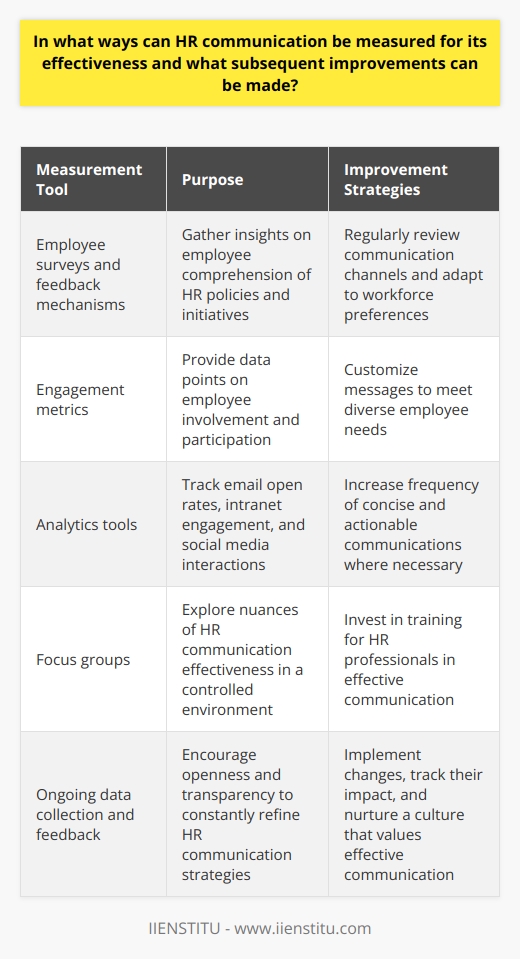
In today's fast-paced and intricately networked business environment, the role of Human Resources (HR) extends beyond hiring, firing, and managing benefits. Communication within HR assumes a pivotal position in orchestrating the strategic direction and connection between an organization's management and its workforce.
This article shall delve into the nuanced world of HR communication, explicating its relevance, dissecting its components, exploring strategies for enhancement, addressing common challenges faced, and contemplating the future that beckons.
Steeped in expertise, the ensuing discussion promises a comprehensive exploration tailored for HR practitioners, organizational leaders, and those aspiring towards excellence in HR through professional development opportunities such as hr certification courses or online courses.
Understanding the Relevance of HR Communication
Explanation of HR Communication
HR communication is the structured transmission of information and understanding between HR professionals and the various stakeholders within an organization, including employees, management, and external partners. It is the lifeblood that sustains the organizational body, ensuring that information is not only shared but understood and acted upon. Precise and strategic communication from HR can drive engagement, foster culture, and precipitate the effectiveness of HR policies and procedures.
The Role of HR Communication in an Organization
HR communication undergirds the organizational structure, conveying expectations, feedback, changes, and decisions. It plays a crucial role in guiding employee behavior, shaping organizational culture, and facilitating change management. Effective communication ensures that employees are motivated, informed about their roles and responsibilities, and aligned with the organization's objectives.
Benefits and Implications of Effective HR Communication
The benefits of potent HR communication are manifold and profound. It enhances employee engagement, lead to higher job satisfaction, and reduces turnover. Moreover, it ensures compliance with policies and the law, reduces misunderstandings, and improves productivity. On the strategic front, it has the ability to reinforce the employer brand, attract top talent, and maintain a competitive edge in the marketplace.
Components of Effective HR Communication
Clarity in Message Delivery: Conveying information with utmost clarity is more than a necessity – it is an art. Ambiguity is the bane of HR communication, leading to confusion and misinterpretation. Clarity in messages fosters understanding and facilitates prompt and accurate responses from employees.
Consistency in Communication: Communicating with a steady and uniform voice and message instills confidence and reliability. It reduces the chance of mixed messages that can lead to skepticism and unrest within the workforce. Consistently reinforced core values and policies weave a strong organizational culture.
Timeliness and Relevance: In the arena of HR, the aphorism 'timing is everything' holds significant weight. Delivering information as and when required, and ensuring it is relevant to the recipients, is crucial. This implies not only distributing timely updates but also refraining from overloading stakeholders with non-essential information.
Techniques for Improving HR Communication
Incorporating Technology
Use of Intranet, Emails, and Employee Portals
Technology has revolutionized HR communication, offering platforms such as intranets, emails, and employee portals for disseminating information efficiently and securely. These tools enable the customization of messages, facilitate instant sharing, and allow for an archive of communications.
Leveraging Social Media Platforms
Social media has permeated the corporate sphere, proving to be a dynamic channel for HR communication. It can be utilized for employer branding, internal networking, and fostering a more informal, yet direct, avenue of communication with the workforce.
Using Mobile Communication Tools
The ubiquity of smartphones has made mobile communication tools imperative for HR professionals. Apps and mobile-optimized platforms enable real-time communication, reaching employees on-the-go and facilitating a more immediate connection.
Regular Training and Workshops
Investing in hr certification courses and conducting regular training and workshops for both HR professionals and employees can significantly enhance communication skills. It's a space where best practices are shared, awareness about communication channels is disseminated, and new tools and techniques are introduced.
Common Challenges of HR Communication
Barriers and Pitfalls in HR Communication
Despite the best intentions, HR communication can encounter a range of barriers including cultural differences, generational gaps, jargon, and resistance to change. These barriers can cloud the clarity, effectiveness, and purpose of communication.
Impact of Poor HR Communication on the Organization
Hr Change Agents Harnessing Power Of Transformation Strategies
How To Align Hrm Strategy And Leadership To Create Successful Employer Brand
The implication of poor communication is far-reaching. It can result in disengaged employees, decreased productivity, and even legal issues. The ripple effect is felt throughout the organization, weakening trust and morale, potentially leading to a toxic work environment.
Strategies to Overcome These Challenges
To navigate these waters, HR professionals must adopt a multi-faceted approach that includes active listening, empathy, clear and concise messaging, as well as providing multiple channels and formats for communication to cater to diverse employee needs and preferences.
To encapsulate, HR communication remains an indispensable component of organizational success. As we journey through the corridors of increasing complexity in our work environments, the need for HR professionals to continuously hone their communication strategies becomes all the more apparent.
By drawing insights from the nuances discussed, and remaining committed to improvement and adaptation, the path towards effective HR communication can be realized. The mastery of this art will not only enhance individual and organizational performance but will also contribute to the enactment of a workplace that is both productive and harmonious.
Frequently Asked Questions
What are the essential strategies that can improve the effectiveness of HR communication within an organization?
Understanding Communication in HR
Effective communication lies at the heart of successful human resource management. It ensures clarity, fosters a sense of community, and aligns the workforce with the organization's goals. We must recognize the multi-faceted nature of communication as a tool for solving issues, inspiring action, and informing strategy.
Strategies for Enhancing HR Communication
Streamline Communication Channels
Complex systems dilute messages. Simplify for impact. Use preferred tools for reach and engagement. Understand employee preferences. Tailor your approach.
Embrace Transparency
Cultivate trust with openness. Share pertinent information widely. Avoid secrecy to prevent rumors. Transparency promotes a shared purpose.
Promote Two-Way Dialogue
Interactive exchanges yield better insights. Facilitate employee feedback. Listen to concerns and suggestions. Genuine dialogue signals value and respect.
Provide Timely Information
Delays cause speculation and anxiety. Communicate changes swiftly. Update often to avoid misinformation. Timeliness ensures relevance.
Customize Messages
One-size-fits-all fails to engage. Customize content for different groups. Address unique team needs. Personalized communication bolsters relevance.
Leverage Technology Smartly
Digital tools offer powerful platforms. Choose technologies that integrate seamlessly. Train staff to use them efficiently. Technology empowers consistent and broad messaging.
Recognize Cultural Differences
Diversity influences reception and interpretation. Acknowledge cultural nuances. Adapt your message accordingly. Sensitive communication builds cohesive teams.
Use Clear and Simple Language
Avoid jargon. It confuses and alienates. Speak plainly to connect universally. Clear language breaks down barriers.
Reinforce Key Messages
Repetition aids retention. Embed core messages across platforms. Use meetings, emails, and informal chats. Consistent reinforcement embeds critical information.
Provide Training for Effective Communication
Equip managers with communication skills. Offer training sessions. Develop their competency. Skilled managers communicate effectively, aiding organizational coherence.
Measure and Adjust
Assess communication strategies' effectiveness. Solicit feedback on delivery methods and content. Adjust tactics according to responses. Improvement follows careful evaluation.
Importance of Ongoing Development
Organizational needs evolve. Communication strategies must follow suit. Remain adaptive to maintain effectiveness. Continuous refinement is essential for keeping communication relevant and effective.
In conclusion, effective HR communication plays a pivotal role in an organization's success. It thrives on simplicity, clarity, and adaptability. Implement these strategies to enhance the way you share and receive information. Strong communication builds a foundation for a resilient and engaged workforce.

How do digital tools and technology influence the communication processes in Human Resources?
The Impact of Digital Tools on HR Communication
Revolutionizing Engagement
Digital tools dramatically reshape HR communication. They foster immediate, transparent dialogues. Such tools range from Employee Self-Service (ESS) platforms to Internal Social Media. Employees can access information, submit requests, and receive feedback swiftly. This instantaneity boosts morale and engagement.
Streamlining Processes
Efficiency stands as a pivotal benefit. Traditional methods, like paper forms and in-person meetings, often slow things down. Digital tools like HR Information Systems (HRIS) automate and simplify processes. They allow for quick updates and data retrieval, cutting down response times.
Recruitment and Onboarding
When it comes to hiring, technology is pivotal. Online platforms now centralize job postings, applications, and reviews. Video interviews connect candidates and recruiters globally. Once hired, new employees onboard through digital orientations and training modules. These steps ensure they are productive faster.
Learning and Development
Career growth demands continuous learning. Digital platforms enable this with online courses and webinars. Employees can learn at their pace, fitting development around their schedules. Moreover, HR can track progress and identify skills gaps more effectively.
Personalization and Analytics
HR communication benefits from personalization. Digital platforms provide tailored experiences based on employee roles and preferences. Additionally, HR analytics mine data for insights. These insights inform decisions and can signal issues before they escalate.
Overcoming Geographical Barriers
The global workforce requires platforms that conquer distance. Tools like videoconferencing and instant messaging bridge these gaps. They connect teams spread across the globe. Employees collaborate as if in the same room.
The Downside
Despite the advantages, digital tools can bring challenges. Over-reliance on technology may harm personal relations. Without face-to-face interaction, misunderstandings occur. People differ in their comfort with technology. HR must ensure tools are user-friendly and accessible to all.
Digital tools revolutionize HR communication. They make processes efficient, foster engagement, and connect globally. Yet, firms must balance technology with humanity. Only then will HR effectively support both business and employee needs.

In what ways can HR communication be measured for its effectiveness and what subsequent improvements can be made?
Understanding HR Communication
Human Resources (HR) stands as the bridge between an organization and its workforce. Effective communication within HR functions is vital. It ensures clear understanding, engagement, and alignment with organizational goals. Proper assessment and improvement of HR communication are thus essential.
Measuring HR Communication Effectiveness
Employee surveys and feedback mechanisms serve as primary tools. They gather insights on how well employees comprehend HR policies and initiatives. Survey results can reflect the level of clarity and relevance of the HR communications.
Engagement metrics further provide data points. Look for trends in employee involvement and participation. Active engagement often signals clear and effective communication.
Analytics tools track email open rates, intranet engagement, and social media interactions. They measure the direct impact of digital HR communications.
Focus groups allow for deeper discussions. They explore the nuances of HR communication effectiveness in a controlled environment.
Implementing Improvements
Improvements stem from understanding the gaps. Regularly review all communication channels. Use survey feedback and engagement data. Adapt to workforce preferences.
Customize messages to meet diverse employee needs. Not all staff digest information the same way. Some prefer email; others, face-to-face meetings or interactive platforms.
Increase the frequency of communications where necessary. More touchpoints can drive home important messages. Ensure these are concise and actionable.
Training for HR professionals in effective communication is vital. Investing in their development pays dividends in clearer HR messaging.
Next Steps
Collect data and feedback regularly. Make it an ongoing process, not a one-off exercise. Encourage openness and transparency. Use the insights to constantly refine HR communication strategies.
Implement changes and track their impact. It's a cycle of continual improvement. Measure, improve, measure again.
Nurturing a culture that values effective communication takes time. Yet, the rewards in terms of employee understanding, satisfaction, and engagement are invaluable.


